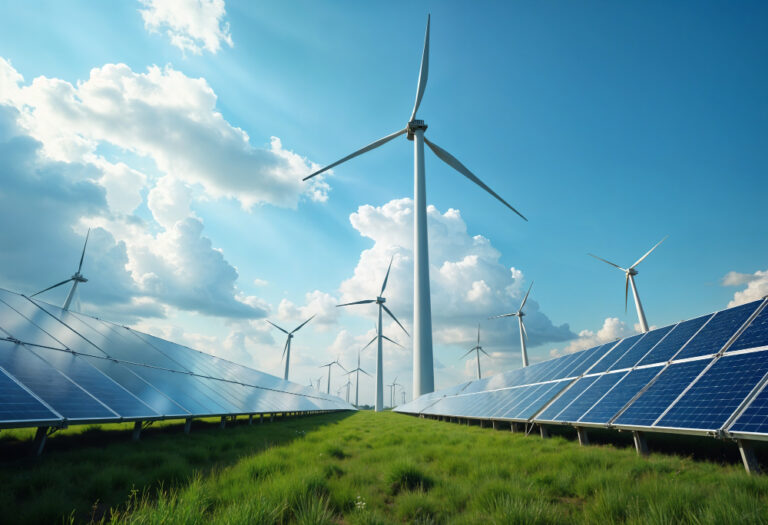Renewable ETFs vs. Traditional ETFs: Which Should You Invest In for 2025 and Beyond?

The race toward clean energy isn’t just transforming the way the world powers its homes, cars, and cities—it’s also reshaping investment strategies. As the renewable energy sector grows rapidly, more investors are considering renewable energy ETFs as a way to align their portfolios with both financial growth potential and environmental values. But how do these funds compare to traditional ETFs that track broad market indexes like the S&P 500 or the total U.S. stock market?
In this comprehensive guide, we’ll break down what renewable ETFs are, how they stack up against traditional ETFs in performance, risk, costs, and diversification, and—most importantly—which option might be right for your investment goals. You’ll get real-world data, expert insights, and actionable takeaways to help make an informed decision.
- 1. Understanding ETFs: The Basics
- 2. What Are Renewable Energy ETFs?
- 3. What Are Traditional ETFs?
- 4. Performance Comparison: Renewable vs. Traditional ETFs
- 5. Risk & Volatility Factors
- 6. Cost & Expense Ratio Analysis
- 7. ESG & Ethical Investing Angle
- 8. Which ETF Type Is Right for You?
- 9. Frequently Asked Questions (FAQs)
- Conclusion & Takeaways
1. Understanding ETFs: The Basics
What Is an ETF?
An Exchange-Traded Fund (ETF) is a basket of securities—stocks, bonds, or other assets—that trades on an exchange like a stock. ETFs are popular for their diversification, low costs, and liquidity.
Two Main Types for Our Comparison
- Renewable Energy ETFs are funds that invest specifically in companies in the clean and renewable energy sectors.
- Traditional ETFs—Broad-market funds that track large indexes like the S&P 500 (SPY) or Vanguard Total Stock Market (VTI).
Why it matters: Knowing the difference helps you align your portfolio with your risk tolerance, ethical values, and return expectations.
2. What Are Renewable Energy ETFs?
Definition: Renewable energy ETFs focus on companies producing power from sustainable sources—solar, wind, hydropower, bioenergy, and increasingly, electric vehicle (EV) infrastructure.
Popular Renewable ETFs in 2025
| ETF Name | Ticker | Focus | Expense Ratio | 3-Year Avg Return |
|---|---|---|---|---|
| iShares Global Clean Energy ETF | ICLN | Broad clean energy | 0.41% | ~30% |
| Invesco Solar ETF | TAN | Solar energy | 0.67% | ~28% |
| Invesco WilderHill Clean Energy ETF | PBW | U.S. clean tech | 0.70% | ~34% |
| First Trust NASDAQ Clean Edge Green Energy | QCLN | Clean tech & EVs | 0.59% | ~29% |
Pros
- Exposure to high-growth sectors
- Aligns with ESG (Environmental, Social, Governance) investing
- Potential for above-market returns in the long term
Cons
- Higher volatility due to policy and technology changes
- Higher fees compared to broad-market ETFs
- Sector concentration risk
3. What Are Traditional ETFs?
Definition: Traditional ETFs track a wide market index, offering broad diversification across industries.
Popular Traditional ETFs
| ETF Name | Ticker | Focus | Expense Ratio | 10-Year Avg Return |
|---|---|---|---|---|
| Vanguard Total Stock Market ETF | VTI | U.S. stock market | 0.03% | ~11.8% |
| SPDR S&P 500 ETF | SPY | S&P 500 index | 0.09% | ~11.9% |
| Vanguard FTSE All-World ex-US ETF | VEU | International stocks | 0.07% | ~6.4% |
Pros
- Low expense ratios (often <0.10%)
- Broad diversification reduces risk
- More predictable long-term returns
Cons
- Limited exposure to fast-growing renewable energy sector
- Returns may lag high-growth niche industries in bull markets.
4. Performance Comparison: Renewable vs. Traditional ETFs
Over the last decade, renewable ETFs have shown periods of outperformance but also sharp pullbacks.
Historical Performance Snapshot
| Fund | 3-Year Avg Return | 5-Year Avg Return | 10-Year Avg Return |
|---|---|---|---|
| ICLN | ~30% | ~13.5% | ~13.5% |
| TAN | ~28% | ~12.8% | ~12.4% |
| VTI | ~11% | ~11.5% | ~11.8% |
| SPY | ~10.9% | ~11.6% | ~11.9% |
Key Insights:
- Renewable ETFs can outperform traditional ETFs in bull markets for clean energy.
- They tend to be more volatile, with larger drawdowns during downturns.
- Traditional ETFs have delivered steady and predictable growth over decades.
5. Risk & Volatility Factors
Renewable ETF Risks:
- Policy changes (e.g., government subsidies or carbon tax laws)
- Technological disruptions (battery breakthroughs, grid limitations)
- Commodity price swings (e.g., lithium for batteries)
Traditional ETF Risks:
- Broader market downturns (recessions, inflation spikes)
- Sector-specific downturns in dominant industries like tech or finance
Beta Values: Many renewable ETFs have a beta of 1.2–1.5, meaning they’re 20–50% more volatile than the broader market.
6. Cost & Expense Ratio Analysis
Why It Matters: Even small differences in expense ratios can compound significantly over decades.
- Renewable ETFs: Typically 0.41–0.75%
- Traditional ETFs: Often 0.03–0.09%
Example:
A $10,000 investment over 20 years earning 8% annually:
- With 0.05% expense ratio → ~$46,610
- With 0.70% expense ratio → ~$42,479
That’s over $4,000 lost to fees.
7. ESG & Ethical Investing Angle
More investors are choosing investments that reflect their values. ESG investing has grown into a multi-trillion-dollar industry.
Renewable ETFs’ ESG Advantage:
- Direct exposure to companies driving the clean energy transition
- Appeal to climate-conscious investors
- Increasing inflows after major climate policy announcements (e.g., U.S. Inflation Reduction Act)
Traditional ETFs and ESG:
- Some broad-market ETFs are adding ESG-screened variants (e.g., ESGV from Vanguard).
- Still include fossil fuel companies unless explicitly excluded.
8. Which ETF Type Is Right for You?
Choose Renewable ETFs if:
- You have a long-term growth horizon (10+ years).
- You can tolerate higher volatility.
- You value sustainability and ESG investing.
Choose traditional ETFs if:
- You prefer lower fees and stable growth.
- You want broad diversification.
- You have a lower risk tolerance.
Balanced Approach:
Many investors choose a core-satellite strategy:
- Core: 70–80% in traditional ETFs for stability
- Satellite: 20–30% in renewable ETFs for growth.
9. Frequently Asked Questions (FAQs)
Are renewable ETFs more volatile than traditional ETFs?
Yes—due to their sector focus and reliance on policy incentives, renewable ETFs tend to have higher volatility.
Which renewable ETFs have the highest returns?
In recent years, PBW and ICLN have led in performance, but results vary year-to-year.
How do renewable ETFs perform in a recession?
They often underperform during market downturns due to reduced investor risk appetite for growth sectors.
What’s the cheapest ETF to invest in?
Among broad-market ETFs, Vanguard Total Stock Market ETF (VTI) has an expense ratio of just 0.03%.
Also: Best Renewable Energy Investment Funds & ETFs for 2025 | Top Clean Energy Picks
Conclusion & Takeaways
There’s no one-size-fits-all answer in the renewable ETFs vs. traditional ETFs debate.
- If your goal is stable, predictable returns with minimal fees, traditional ETFs are a proven choice.
- If you want to capture growth in the global shift to clean energy—and you’re comfortable with higher volatility—renewable ETFs offer compelling opportunities.
- A blended approach could give you the best of both worlds.
Action Steps:
- Review your investment horizon and risk tolerance.
- Compare ETF performance, costs, and holdings.
- Consider speaking with a financial advisor to tailor a portfolio that aligns with both your goals and values.



